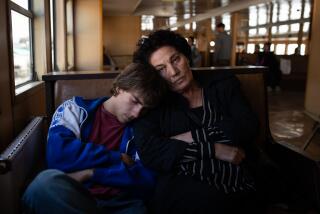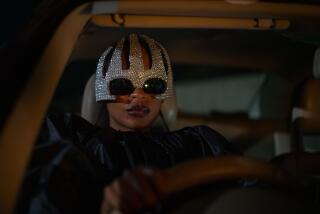MOVIE REVIEW : Excess of Imagination Fills ‘The Man Without a World’
- Share via
“The Man Without a World” is a novel, unorthodox film, inventive and unexpected. However, like many an ambitious project made with the most limited resources, imagination runs ahead of execution, and the audience ends up having to cope with the inevitable defects of the film’s virtues.
“The Man Without a World” (at the Monicas) is first of all a fascinating stylistic experiment. Though it playfully poses as a rediscovered Yiddish silent film emanating from the morose depths of Eastern Europe, it was actually made last year in bucolic Southern California. And though the film starts with an extensive crawl detailing the history of its nominal creator, Yevgeny Antinov, “the controversial Soviet silent film director,” in fact it was written, produced and directed on a shoestring by Eleanor Antin, a professor of visual arts at UC San Diego.
Antin, who also took one of the starring roles, is clearly nothing if not enterprising, and her intentions for this project are several-fold. She wants to re-create not only the abandoned aesthetic of the great days of silent cinema, but also the long-dead world of the European Jewish shtetl, or market town. And she wants to be socially conscious on top of that.
To this end, Antin has concocted a kitchen-sink plot that deals with not only all sorts of emotional crises, from love and death to madness and dissipation, but also makes reference to the heady confluence of powerful societal forces--socialism, Zionism, anarchism, modernism, not to mention religious orthodoxy--that pulled European Jews this way and that.
Almost inevitably with a plot this complex, and true to silent film tradition, most of the characters have epithets attached to them. The protagonist is Zevi the poet (Pier Marton), a ne’er-do-well who hangs out with ruffians while writing poetry on the order of “thy eyes are like fish pools in Bialystok” to a dark-eyed Gypsy ballerina (played by Antin).
Zevi also has eyes for pretty Ruchele (Christine Berry), the beauty of the town, and is saddled with poor mad Sooreleh (Anna Henriques), a sister who was raped during a pogrom. Also making appearances are Reb Eliezar the Cabalist, a love-mad butcher and the now-you-see-him, now-you-don’t Angel of Death.
Given that she worked with a minuscule $100,000 budget, Antin succeeded better than one might have expected, even going so far as constructing a gauze ceiling for her outdoor set to diffuse the too-bright San Diego sun. Her intertitles (in English, though a Yiddish version is apparently available) are apt, and her visual set pieces, though of necessity influenced by such classics as the 1939 sound version of “The Dybbuk,” are intriguing.
When it comes to exposition, however, things work less well. Silent film style is not an easy one to duplicate, especially with nonprofessional actors who are not bred to it, and using a cast that did double duty (Antin’s chiropractor, for instance, plays the Gypsy strong man) means that dramatic scenes are awkward and amateurish more often than not. So it’s almost inevitable that the audacity of what Antin has attempted ends up makes a more lasting impression than what is visible on the screen.
‘The Man Without a World’
Pier Marton: Zevi
Christine Berry: Rukheleh
Anna Henriques: Sooreleh
Eleanor Antin: The ballerina
Nicolai Lennox: The strong man
Released by Milestone Films. Written, produced and directed by Eleanor Antin. Cinematographer Rich Wargo. Editor Lynn Burnstan. Costumes Judy Ryerson. Music Charles Morrow & Lee Erwin. Art director Sabato Fiorello. Set design Roger Sherman. Running time: 1 hour, 38 minutes.
More to Read
Only good movies
Get the Indie Focus newsletter, Mark Olsen's weekly guide to the world of cinema.
You may occasionally receive promotional content from the Los Angeles Times.







